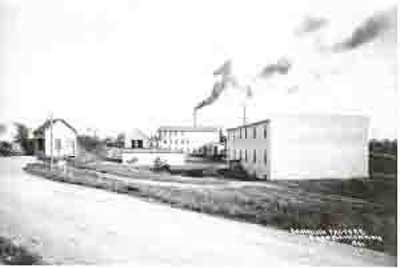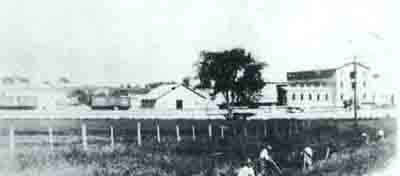|
View is looking east. The road in front is highway 55. The photographer is standing just south of Pleasant Hill Avenue, now called Pilgrim Road.
"I know the Canning Factory from 1948 when I worked there. Using the first picture as reference, starting with the left side, a small building on top of the hill was the weight scale. This was run by my Dad. It weighed the load and took a sample of the vegetable or whatever was there. This was how the farmer got paid for his load. Some of the loads came in by wagon pulled by horses and some by truck (gas was .25 a gallon then....here today [2007] it is 2.68 a gallon.) Across highway 55 was a row of viners and the load went from the weight scale to the viners where all the vines and excess leaves were taken off. A small wagon was used to haul the peas across the road. The viners were only used for the peas. There were also two viners in a shed to the right in the picture with big open doors and these were the same as the viners across the street. This building was attached to a three story high large building where the peas were sorted, canned and packed and boiled. The top floor was storage for paper and tin cans without the tops on. These cans came in on the railroad that ran parallel to the building. The second floor was the sorting room where there was two rows of conveyer belts with women sitting on both sides picking thistle heads and debris leaving the peas. From here the peas went down a tube to the canner and went in cans and swirled around with a little water. The tops were put on the cans and the covers were stamped a code that marked the softness, hardness and size of the peas. The filled cans put in to a box (round big container) and carried out to the front of the area. They were raised up with a hoist and put in two of those big containers and were pushed into a boiler and sealed. Steam was put in from the boiler plant which was south of the building and can't be seen on the picture. After the cooking was done, I think a couple of hours, they were taken out and allowed to cool. They were wheeled over to centrifugal machine on which cans were placed and they spun around to make a single aisle and onto a track that ran to the warehouse. They were put into boxes and stored. When anyone ordered say peas, say a gross or so, they were labeled and sent out by rail. Pickles Pfeil brought coal here to the steam plant. They also canned beets besides the peas and corn. Bud Schryer was my boss. He later worked with Wesley Stahmer, who built a building in that area and from it distributed sugar. The building on the above picture which is front most and two stories I have no idea what it is. It was not there I don't believe when I worked there." A side note: In the Christ Evangelical Church 95th anniversary booklet, published in 1937, the Germantown Canning Company was a sponsor. In their advertisment it read ... Packers of Fancy Wisconsin Peas, Tomatoes, Tomato Juice and Red Beets ... Brands: "Elegante", "Like Me", "Mutual".
|

